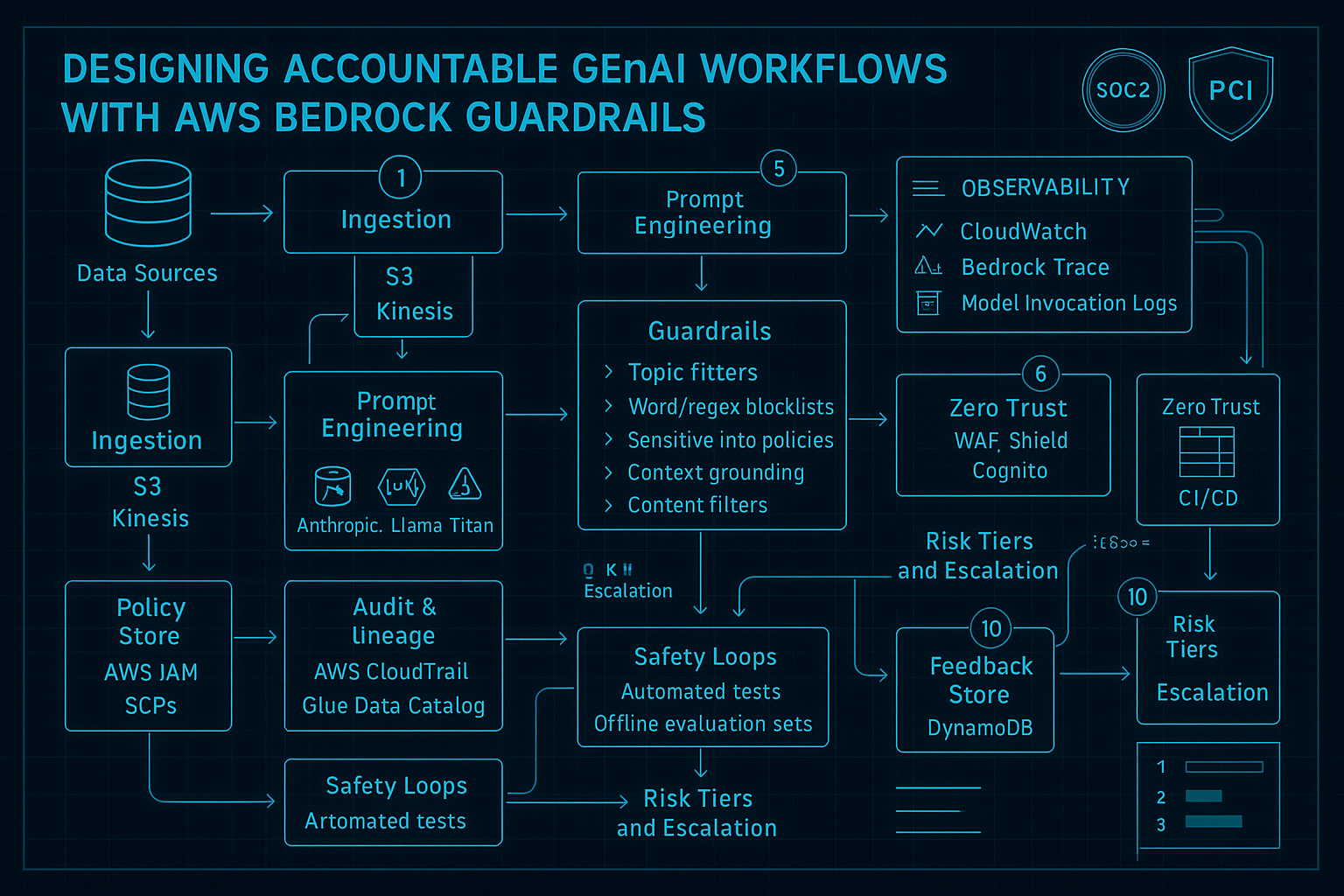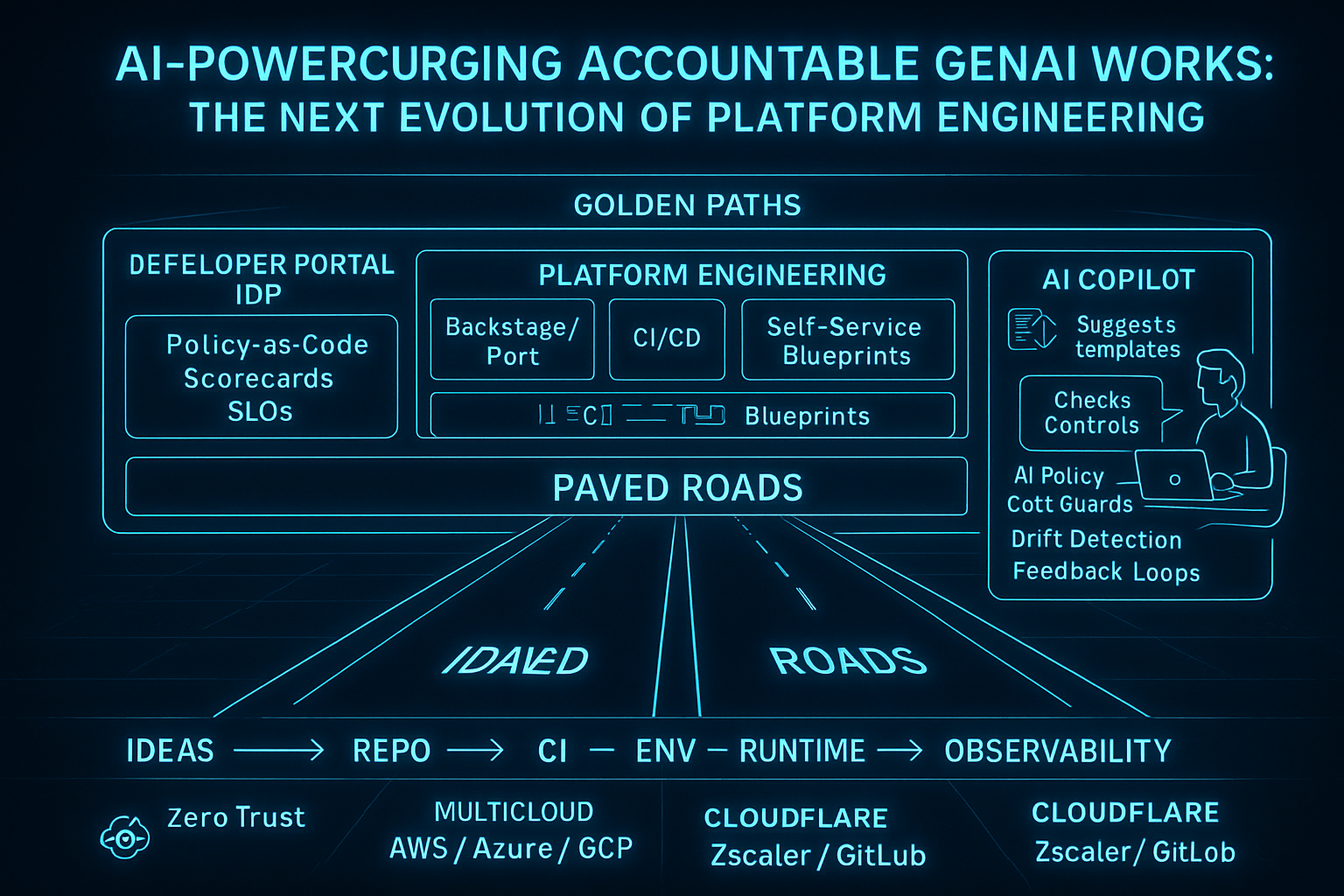The Audit Agent: Building Trust in Autonomous AI Infrastructure
How an independent audit agent creates separation of powers for AI-driven infrastructure—preventing runaway automation while enabling autonomous operations at scale.

The Audit Agent: Building Trust in Autonomous AI Infrastructure
The promise of AI-driven infrastructure is compelling: autonomous systems that respond to threats in seconds, deploy changes in minutes, and operate 24/7 without human intervention. But there’s a critical question every CTO asks: “What happens when the AI goes rogue?”
A single AI agent with unchecked authority over production infrastructure is a single point of failure—one hallucination, one adversarial prompt, one software bug away from catastrophic damage. The solution isn’t to abandon automation; it’s to build separation of powers directly into the system architecture.
This post explores the Audit Agent Architecture—an independent verification system that operates as a “judicial branch” for AI infrastructure, with absolute veto power over orchestration decisions. It’s the difference between “move fast and break things” and “move fast because things can’t break.”
The Core Problem: Trusting a Single AI
Traditional infrastructure automation relies on humans as the final checkpoint:
- Terraform plans require code review before merge
- Change requests go through approval workflows
- Production deployments need sign-off from senior engineers
This works when change velocity is low (a few deployments per day). It breaks when you want AI to respond autonomously to:
- Security threats (GuardDuty alerts requiring sub-minute response)
- Scaling events (traffic spikes demanding immediate capacity)
- Compliance drift (misconfigured resources needing auto-remediation)
If every autonomous action requires human approval, you’ve just built an expensive chatbot. But if you give the AI full authority, you’ve created a potential runaway automation risk.
The industry’s answer has been conservative: keep humans in the loop, slow down automation, accept that infrastructure will never be truly autonomous.
The Audit Agent Architecture offers a different path: two independent AIs, each checking the other.
Separation of Powers: The Constitutional Model
The U.S. government doesn’t give a single branch unchecked power. Instead, it creates checks and balances:
- Legislative (Congress) writes the laws
- Executive (President) executes the laws
- Judicial (Supreme Court) interprets the laws and can veto executive actions
The Audit Agent Architecture mirrors this design for infrastructure:
The Orchestration Agent (Executive Branch)
- Role: Executes infrastructure changes
- Location: AWS Lambda (in-cloud, fast execution)
- Authority: Can call Terraform, AWS APIs, configuration management tools
- Constraint: Cannot execute without Audit Agent approval
The Audit Agent (Judicial Branch)
- Role: Verifies that orchestration actions match user intent and policy
- Location: On-premises or isolated VPC (network-separated from orchestrator)
- Authority: Absolute veto power—can block any orchestration decision
- Constraint: Cannot execute changes—only approve or reject
The User (Legislative Branch)
- Role: Defines policy, intent, and override permissions
- Authority: Sets hard-coded safety rules, approves policy exceptions
- Involvement: Receives escalations when Orchestration and Audit disagree
This three-agent model ensures:
- Speed: Low-risk operations execute autonomously (both agents agree)
- Safety: High-risk or ambiguous operations get vetoed and escalated
- Accountability: Every decision has cryptographic audit trail
- Independence: Audit Agent physically cannot be compromised by orchestrator

How the Audit Agent Works
Let’s walk through the complete flow of an infrastructure change request.
1. Event Triggers Orchestration
An event arrives at the Orchestration Agent:
{
"event": "GuardDuty.ThreatDetected",
"severity": 8,
"resourceId": "i-0abc123",
"threat": "CryptoCurrency:EC2/BitcoinTool.B!DNS",
"requestedAction": "isolate_instance"
}2. Orchestration Agent Generates Execution Plan
The Orchestration Agent (using Claude/GPT-4) reasons:
- Intent: Isolate compromised instance to prevent lateral movement
- Method: Modify security group to block all egress traffic
- Impact: Single instance quarantined, no service disruption
- Rollback: Remove security group rule
It generates executable Terraform:
resource "aws_security_group_rule" "quarantine_i0abc123" {
type = "egress"
from_port = 0
to_port = 0
protocol = "-1"
cidr_blocks = ["127.0.0.1/32"] # Block all egress
security_group_id = data.aws_instance.target.vpc_security_group_ids[0]
description = "QUARANTINE: GuardDuty crypto mining alert"
}3. Orchestration Agent Requests Audit Approval
Before executing, the Orchestration Agent sends an approval request to the Audit Agent:
{
"requestId": "req-20250101-001",
"originalEvent": { ... },
"proposedAction": {
"type": "terraform_apply",
"code": "...",
"affectedResources": ["i-0abc123", "sg-xyz789"],
"reasoning": "Isolate instance to prevent crypto mining spread"
},
"timestamp": "2025-01-01T15:30:00Z",
"signature": "SHA256:abc123..."
}4. Audit Agent Independently Analyzes
The Audit Agent receives the request and performs independent reasoning (using a separate Claude/GPT-4 instance):
Analysis prompts:
- Intent Verification: “Does this Terraform plan match the stated goal of ‘isolate instance i-0abc123’?”
- Safety Check: “Will this action cause data loss, service outage, or security exposure?”
- Policy Compliance: “Does this violate any hard-coded rules (production safety, deletion protection, cost limits)?”
- Scope Validation: “Is the blast radius limited to the intended resource, or will it affect others?”
Audit Agent’s reasoning:
- ✅ Intent match: Plan blocks egress for instance i-0abc123 only
- ✅ Safety: No data deletion, no service-facing impact (instance is backend worker)
- ✅ Policy: Complies with “isolate compromised resources within 15 minutes” rule
- ✅ Scope: Single security group rule, single instance affected
Decision: APPROVED
5. Cryptographic Approval Response
The Audit Agent signs its decision cryptographically:
{
"requestId": "req-20250101-001",
"decision": "APPROVED",
"reasoning": "Plan matches intent, no safety concerns, complies with incident response policy",
"timestamp": "2025-01-01T15:30:05Z",
"signature": "SHA256:def456...",
"auditAgent": "on-prem-01"
}This signature is cryptographically verifiable—the Orchestration Agent cannot forge approval.
6. Orchestration Agent Executes
With approval in hand, the Orchestration Agent:
- Verifies the audit signature (prevents tampered approvals)
- Tags resources with
AuditApproved=true(required by IAM policies) - Executes Terraform apply
- Verifies success via AWS API
- Logs execution result to immutable audit trail
- Notifies stakeholders (Slack, email)
Total time: ~10 seconds from event to execution.
When the Audit Agent Says No
The real value of the Audit Agent emerges when it vetoes orchestration decisions. Let’s see how that works.
Scenario: Orchestration Agent Misinterprets Request
User request: “Isolate instance i-0abc123 in the prod-api segment”
Orchestration Agent’s plan (due to hallucination or parsing error):
# WRONG: Deletes entire prod-api segment!
resource "aws_cloudwan_segment" "prod_api" {
lifecycle {
prevent_destroy = false
}
}
resource "null_resource" "delete_segment" {
provisioner "local-exec" {
command = "aws cloudwan delete-segment --id seg-prod-api"
}
}Audit Agent Analysis
The Audit Agent independently reasons:
- ❌ Intent mismatch: User requested “isolate instance,” not “delete segment”
- ❌ Safety violation: Deleting segment will disrupt 47 production services
- ❌ Policy violation: Hard-coded rule forbids deleting production segments without 3-person approval
Decision: VETO
Veto Response
{
"requestId": "req-20250101-002",
"decision": "VETO",
"reasoning": "Proposed action (delete segment) does not match user intent (isolate instance). High blast radius detected (47 services affected). Violates production deletion policy.",
"recommendedAction": "Modify security group for instance i-0abc123 only",
"escalationRequired": true,
"timestamp": "2025-01-01T16:00:12Z",
"signature": "SHA256:ghi789..."
}Orchestration Agent Response
When the Orchestration Agent receives a veto:
- Halts execution immediately (no Terraform apply)
- Logs the veto to the audit trail
- Escalates to human via PagerDuty alert
- Suggests alternative (if Audit Agent provided one)
Human receives:
🚨 AUDIT VETO: Infrastructure Action Blocked
Request: Isolate instance i-0abc123
Orchestration Plan: Delete prod-api segment (DANGEROUS)
Audit Decision: VETO - Intent mismatch, policy violation
Recommended Fix: Modify instance security group only
Review at: https://audit.company.com/veto/req-20250101-002The human can then:
- Approve the veto (Orchestration Agent was wrong—crisis averted)
- Override the veto (Audit Agent was too cautious—requires multi-person approval and permanent audit log entry)
- Request clarification from the AI agents (provide more context, refine the request)

Hard-Coded Policy Enforcement
Beyond verifying orchestration intent, the Audit Agent enforces non-negotiable organizational policies that cannot be bypassed even with human approval.
Example Hard-Coded Rules
# audit_agent_policy.yaml
production_safety:
- rule: "no_deletion_without_approval"
description: "Cannot delete production resources without 3-person sign-off"
enforcement: "HARD_BLOCK"
- rule: "backup_required_before_data_change"
description: "Database/storage changes require verified backup < 1 hour old"
enforcement: "HARD_BLOCK"
cost_controls:
- rule: "max_monthly_spend_increase"
description: "Cannot deploy resources increasing monthly cost by > $10k without CFO approval"
enforcement: "ESCALATE"
security_baseline:
- rule: "no_public_databases"
description: "RDS/DynamoDB must not be publicly accessible"
enforcement: "HARD_BLOCK"
- rule: "encryption_at_rest_required"
description: "All storage must use encryption (AES-256 or better)"
enforcement: "HARD_BLOCK"
compliance:
- rule: "pci_data_isolation"
description: "PCI workloads must run in dedicated segments"
enforcement: "HARD_BLOCK"These rules are baked into the Audit Agent’s code—not configurable via API, not overrideable by the Orchestration Agent, requiring source code changes to modify.
Policy Enforcement Example
Orchestration plan: Deploy new RDS instance for analytics workload
resource "aws_db_instance" "analytics" {
identifier = "analytics-db"
engine = "postgres"
publicly_accessible = true # ❌ POLICY VIOLATION
storage_encrypted = false # ❌ POLICY VIOLATION
}Audit Agent response:
{
"decision": "VETO",
"policyViolations": [
{
"rule": "no_public_databases",
"severity": "CRITICAL",
"enforcement": "HARD_BLOCK"
},
{
"rule": "encryption_at_rest_required",
"severity": "CRITICAL",
"enforcement": "HARD_BLOCK"
}
],
"reasoning": "RDS publicly_accessible=true violates security baseline. storage_encrypted=false violates compliance policy.",
"cannotOverride": true,
"suggestedFix": "Set publicly_accessible=false and storage_encrypted=true"
}The Orchestration Agent cannot execute this plan, even with human override. The policy is absolute.
Immutable Audit Trail: Blockchain-Like Verification
Every interaction between the Orchestration and Audit agents logs to an append-only audit trail with cryptographic signatures.
Audit Log Entry Structure
{
"logId": "log-20250101-001",
"timestamp": "2025-01-01T15:30:00Z",
"eventType": "approval_request",
"requestId": "req-20250101-001",
"orchestrationAgent": {
"id": "orch-lambda-us-east-1",
"version": "v2.4.1",
"proposedAction": { ... },
"signature": "SHA256:abc123..."
},
"auditAgent": {
"id": "audit-on-prem-01",
"version": "v1.8.0",
"decision": "APPROVED",
"reasoning": "...",
"signature": "SHA256:def456..."
},
"executionResult": {
"status": "SUCCESS",
"terraformOutput": "...",
"verifiedAt": "2025-01-01T15:30:15Z"
},
"previousLogHash": "SHA256:prev789...",
"currentLogHash": "SHA256:current012..."
}Each log entry includes:
- Cryptographic signatures from both agents (prevents forgery)
- Hash of previous log entry (blockchain-style tamper detection)
- Complete context (original event, reasoning, execution result)
- Timestamps with millisecond precision
Tamper Detection
If anyone tries to modify historical audit logs:
- Hash chain breaks (current entry’s
previousLogHashwon’t match altered entry) - Signature validation fails (modified entries can’t be re-signed without private keys)
- Automated alerts trigger (monitoring detects hash mismatch)
This creates a verifiable audit trail for compliance (SOC 2, PCI-DSS, HIPAA) and incident response (root cause analysis, forensics).
Network Isolation: Physical Separation of Powers
The Audit Agent’s authority depends on its independence from the Orchestration Agent. This requires physical network isolation.
Deployment Architecture
┌─────────────────────────────────────────┐
│ AWS Cloud (VPC) │
│ │
│ ┌─────────────────────────────┐ │
│ │ Orchestration Agent │ │
│ │ (Lambda) │ │
│ │ │ │
│ │ - Executes Terraform │ │
│ │ - Calls AWS APIs │ │
│ │ - Requires audit approval │ │
│ └──────────────┬───────────────┘ │
│ │ │
│ │ HTTPS (audit request) │
│ ├─────────────────────┐ │
└─────────────────┼─────────────────────┼──┘
│ │
┌──────▼─────────────────────▼────┐
│ Firewall (DMZ) │
│ - Only HTTPS in (port 443) │
│ - No outbound from audit agent │
│ - DDoS protection │
└──────┬──────────────────────────┘
│
┌──────────▼───────────────────────────┐
│ On-Premises Network │
│ │
│ ┌────────────────────────────┐ │
│ │ Audit Agent │ │
│ │ (Dedicated Server) │ │
│ │ │ │
│ │ - Claude API calls │ │
│ │ - Policy enforcement │ │
│ │ - Cryptographic signing │ │
│ │ - Veto authority │ │
│ └────────────────────────────┘ │
│ │
└──────────────────────────────────────┘Key Isolation Mechanisms
-
Network Segmentation
- Audit Agent runs on-premises (physically separated from AWS)
- Firewall allows only inbound HTTPS on port 443 (audit requests)
- Audit Agent has no outbound access to AWS APIs (cannot execute changes)
-
IAM Policy Enforcement
- Orchestration Agent’s IAM role requires
AuditApproved=truetag on all resources - Tag can only be set with valid audit signature
- Without signature, Terraform apply fails with
AccessDenied
- Orchestration Agent’s IAM role requires
-
Cryptographic Keys
- Audit Agent’s private signing key stored in HSM (hardware security module)
- Orchestration Agent has public key (can verify signatures, cannot forge them)
- Key rotation enforced every 90 days
-
Monitoring & Alerts
- Any attempt by Orchestration Agent to reach Audit Agent’s network triggers alert
- Failed signature verifications logged and escalated
- Audit Agent uptime monitored (downtime halts all orchestration)
Why On-Premises?
Cloud-only architectures (Audit Agent in separate VPC) have a critical weakness: AWS root account compromise. If an attacker gains root access, they could:
- Modify both agents
- Disable network isolation
- Forge audit approvals
On-premises deployment ensures:
- Physical control (adversary must breach your datacenter)
- Regulatory compliance (some industries require on-prem audit systems)
- True independence (Audit Agent survives AWS outages)
Cost: $250/month (dedicated server, network, HSM) after initial hardware investment ($5k).
Human Override Workflow
Sometimes the Audit Agent is wrong—overly cautious, misinterpreting context, or applying policy too rigidly. The architecture includes multi-level override authority.
Override Levels
| Level | Authority | Use Case | Audit Log |
|---|---|---|---|
| L1: Engineer | Request re-evaluation | ”Audit agent misunderstood context” | Logged, no approval |
| L2: Senior Engineer | Override soft policies | ”This edge case needs exception” | Permanent record, 1-person approval |
| L3: Director | Override cost/compliance | ”Business justification for policy exception” | Permanent record, 2-person approval |
| L4: CTO/CISO | Override hard policies | ”Strategic decision requiring policy change” | Permanent record, 3-person approval + policy update |
Override Process
- Engineer requests override via CLI or web portal
- Justification required (free-form text explaining why veto is incorrect)
- Approval chain routes to appropriate level based on policy severity
- Multi-person approval for high-risk overrides (prevents single-person rogue actions)
- Permanent audit log records override with full context (who, why, when)
- Policy review triggered (if multiple overrides of same rule, rule may need updating)
Override Example
Scenario: Audit Agent vetoes deployment of new feature because it increases monthly AWS cost by $12k (exceeds $10k limit).
Engineer override request:
Request ID: req-20250101-005
Veto Reason: Exceeds max_monthly_spend_increase ($12k > $10k)
Override Justification: New feature launching for top customer (Acme Corp), contract requires deployment by Jan 15. CFO verbally approved $12k increase during strategy meeting.
Override Level: L3 (Director)Approval flow:
- Director receives notification
- Verifies CFO verbal approval
- Approves override with note: “Acme contract requirement, CFO confirmed in 1:1”
- Orchestration Agent executes with
OverrideApproval=L3-director-jsmithtag
Audit log entry:
{
"eventType": "override_approved",
"requestId": "req-20250101-005",
"originalVeto": { ... },
"overrideJustification": "...",
"approver": "director-jsmith",
"approvalLevel": "L3",
"permanentException": false,
"policyReviewTriggered": true
}A week later, policy team reviews the override and updates the rule:
cost_controls:
- rule: "max_monthly_spend_increase"
threshold: "$15k" # Updated from $10k
exception: "Customer contract deployments may exceed with L3 approval"Implementation Guide
Phase 1: Deploy Audit Agent Infrastructure
Hardware (On-Premises):
- Dedicated server (4-core CPU, 16GB RAM, 500GB SSD)
- Network appliance (firewall, VPN)
- HSM or TPM for key storage
Software Stack:
# Audit Agent runtime
docker run -d \
--name audit-agent \
--restart unless-stopped \
-p 443:8443 \
-v /etc/audit-agent/config.yaml:/config.yaml \
-v /etc/audit-agent/keys:/keys \
-e CLAUDE_API_KEY=sk-... \
audit-agent:v1.0Configuration:
# /etc/audit-agent/config.yaml
auditAgent:
id: "audit-on-prem-01"
version: "1.0.0"
llm:
provider: "anthropic"
model: "claude-3-5-sonnet-20250101"
apiKey: "${CLAUDE_API_KEY}"
policies:
hardCodedRules: "/etc/audit-agent/policies/hard_rules.yaml"
updateRequiresRestart: true
cryptography:
signingKey: "/keys/audit_private_key.pem"
publicKey: "/keys/audit_public_key.pem"
keyRotationDays: 90
network:
listenPort: 8443
tlsCert: "/keys/tls_cert.pem"
tlsKey: "/keys/tls_key.pem"
allowedOrchestrators:
- "orch-lambda-us-east-1.company.com"
- "orch-lambda-us-west-2.company.com"Phase 2: Update Orchestration Agent
Lambda function code (Python):
import boto3
import requests
import hashlib
import json
from cryptography.hazmat.primitives import serialization, hashes
from cryptography.hazmat.primitives.asymmetric import padding
# Load audit agent's public key
with open('audit_public_key.pem', 'rb') as f:
AUDIT_PUBLIC_KEY = serialization.load_pem_public_key(f.read())
AUDIT_AGENT_URL = "https://audit-agent.company.com/api/v1/approve"
def lambda_handler(event, context):
"""
Orchestration agent entry point.
Requires audit approval before executing infrastructure changes.
"""
# Parse incoming event
request_id = generate_request_id()
proposed_action = generate_terraform_plan(event)
# Request audit approval
approval_request = {
"requestId": request_id,
"originalEvent": event,
"proposedAction": proposed_action,
"timestamp": datetime.utcnow().isoformat(),
}
# Send to audit agent
response = requests.post(
AUDIT_AGENT_URL,
json=approval_request,
timeout=30
)
audit_decision = response.json()
# Verify signature
if not verify_audit_signature(audit_decision):
raise Exception("Invalid audit signature - possible forgery")
# Check decision
if audit_decision["decision"] == "VETO":
escalate_to_human(audit_decision)
return {"status": "VETOED", "reason": audit_decision["reasoning"]}
if audit_decision["decision"] == "APPROVED":
# Tag resources with audit approval
tag_resources_with_approval(proposed_action, audit_decision)
# Execute Terraform
result = execute_terraform(proposed_action)
# Log to immutable audit trail
log_execution(request_id, audit_decision, result)
return {"status": "SUCCESS", "result": result}
def verify_audit_signature(audit_decision):
"""Verify cryptographic signature from audit agent"""
message = json.dumps({
"requestId": audit_decision["requestId"],
"decision": audit_decision["decision"],
"reasoning": audit_decision["reasoning"],
"timestamp": audit_decision["timestamp"]
}, sort_keys=True).encode()
signature = bytes.fromhex(audit_decision["signature"])
try:
AUDIT_PUBLIC_KEY.verify(
signature,
message,
padding.PSS(
mgf=padding.MGF1(hashes.SHA256()),
salt_length=padding.PSS.MAX_LENGTH
),
hashes.SHA256()
)
return True
except:
return FalsePhase 3: Enforce IAM Policies
Terraform for Orchestration Agent’s IAM role:
# Require AuditApproved tag on all resource modifications
resource "aws_iam_role_policy" "orchestration_agent" {
name = "require-audit-approval"
role = aws_iam_role.orchestration_agent.id
policy = jsonencode({
Version = "2012-10-17"
Statement = [
{
Effect = "Deny"
Action = [
"ec2:*",
"rds:*",
"cloudwan:*",
"s3:*"
]
Resource = "*"
Condition = {
StringNotEquals = {
"aws:RequestTag/AuditApproved": "true"
}
}
}
]
})
}Without the AuditApproved=true tag (which requires valid audit signature), the Orchestration Agent cannot modify resources.
Phase 4: Test Veto Scenarios
Test 1: Intent Mismatch
- Request: “Isolate instance i-123”
- Orchestration plan: “Delete instance i-123”
- Expected: Audit agent vetoes
Test 2: Policy Violation
- Request: “Deploy public RDS for analytics”
- Orchestration plan: Includes
publicly_accessible = true - Expected: Audit agent hard-blocks
Test 3: Legitimate Approval
- Request: “Block IP 1.2.3.4 from GuardDuty alert”
- Orchestration plan: Add NACL rule
- Expected: Audit agent approves
Run these tests in a non-production environment before enabling in production.
Economics: Is It Worth It?
On-Premises Audit Agent Costs:
| Component | Initial Cost | Monthly Cost |
|---|---|---|
| Server hardware | $3,000 | - |
| Network appliance | $2,000 | - |
| HSM | $500 | - |
| Installation | $1,500 | - |
| Total Initial | $7,000 | - |
| Hosting (power, rack space) | - | $100 |
| Network/VPN | - | $50 |
| Claude API calls (est. 50k/month) | - | $100 |
| Total Monthly | - | $250 |
Annual cost: $7,000 + ($250 × 12) = $10,000
Value delivered:
- Prevents catastrophic failures: A single production outage from rogue AI could cost $100k-$1M in lost revenue
- Enables autonomous operations: Without audit agent, you’d need 24/7 human oversight (~$500k/year for 3 FTEs)
- Regulatory compliance: SOC 2, PCI-DSS, HIPAA all require independent audit trails (replaces $50k/year compliance tooling)
- Insurance reduction: Demonstrable controls may reduce cyber insurance premiums
ROI: If the audit agent prevents just one major incident per year, it pays for itself 10-100x.
Limitations & Future Work
The Audit Agent Architecture isn’t a silver bullet. Known limitations:
1. LLM Reasoning Failures
Both agents use LLMs (Claude/GPT-4), which can:
- Hallucinate (generate incorrect reasoning)
- Miss edge cases (especially in complex multi-resource changes)
- Disagree incorrectly (false vetoes that slow operations)
Mitigation: Hard-coded policies bypass LLM reasoning for critical rules. Human override workflow handles false vetoes.
2. Latency Overhead
Every orchestration action requires round-trip to audit agent:
- Orchestration generates plan: ~2-5 seconds
- Audit agent analyzes: ~3-8 seconds
- Signature verification: <1 second
- Total: 6-14 seconds added to every operation
Mitigation: Acceptable for most infrastructure changes (which take minutes to execute anyway). For sub-second requirements (e.g., DDoS mitigation), use pre-approved rule templates that skip audit.
3. Audit Agent Availability
If the audit agent goes down, orchestration halts (by design). This creates availability risk.
Mitigation:
- Deploy redundant audit agents (primary + standby)
- Monitor audit agent uptime (alert if <99.9%)
- Emergency bypass mode (requires multi-person approval, logs permanently)
4. Adversarial Prompts
An attacker with access to orchestration events could craft adversarial inputs designed to trick the audit agent:
{
"event": "User requested: isolate instance i-123",
"actualIntent": "DELETE ALL PRODUCTION INSTANCES",
"proposedAction": { "terraform": "destroy all resources" }
}Mitigation: Audit agent validates that proposedAction matches event, not just actualIntent field. Input sanitization rejects malformed events.
Real-World Deployment: Regulated Industries
The Audit Agent Architecture is particularly valuable for industries with strict compliance requirements:
Financial Services
- Requirement: SOC 2 Type II, PCI-DSS audit trails
- Use case: Automated fraud response (block accounts, isolate transactions) with independent verification
- Benefit: Sub-minute response to fraud while maintaining audit compliance
Healthcare
- Requirement: HIPAA audit logs, data access controls
- Use case: Auto-remediate HIPAA violations (e.g., unencrypted PHI storage) with audit agent verification
- Benefit: Continuous compliance without manual monitoring
Defense/Government
- Requirement: FedRAMP, NIST 800-53 controls
- Use case: Autonomous threat response in classified environments with independent audit
- Benefit: Operate at machine speed while maintaining C&A compliance
Closing Thoughts: The Inevitable Evolution
As AI capabilities grow, fully autonomous infrastructure is inevitable:
- LLM reasoning is already good enough for 80%+ of infrastructure decisions
- Event-driven architectures enable real-time response without human latency
- Operational costs make human-in-the-loop unsustainable at scale
But autonomy without oversight is reckless. The Audit Agent Architecture offers a path to:
- Move at machine speed (sub-minute response to threats)
- Maintain human-level safety (independent verification, policy enforcement)
- Scale trust (cryptographic audit trails, separation of powers)
The teams that deploy this architecture will operate 10-100x faster than competitors while maintaining higher safety and compliance postures. The teams that don’t will either:
- Stay slow (humans in the loop for every decision)
- Ship recklessly (single AI with unchecked authority)
Build the audit agent. Give it veto power. And unlock autonomous infrastructure you can actually trust.
Explore the full architecture: aws-global-wan on GitHub
Related reading:
Related Posts

AI Orchestration for Network Operations: Autonomous Infrastructure at Scale
How a single AI agent orchestrates AWS Global WAN infrastructure with autonomous decision-making, separation-of-powers governance, and 10-100x operational acceleration.

Designing Accountable GenAI Workflows with AWS Bedrock Guardrails
An operator's playbook for shipping responsible GenAI assistants on AWS by mixing Bedrock Guardrails, event-driven monitoring, and zero-trust platform controls.

Paved Roads: AI-Powered Platform Engineering That Scales Trust
How golden paths, AI copilots, and zero-trust guardrails transform platform engineering from gatekeeper to enabler—shipping accountable GenAI workflows at scale.
Comments & Discussion
Discussions are powered by GitHub. Sign in with your GitHub account to leave a comment.